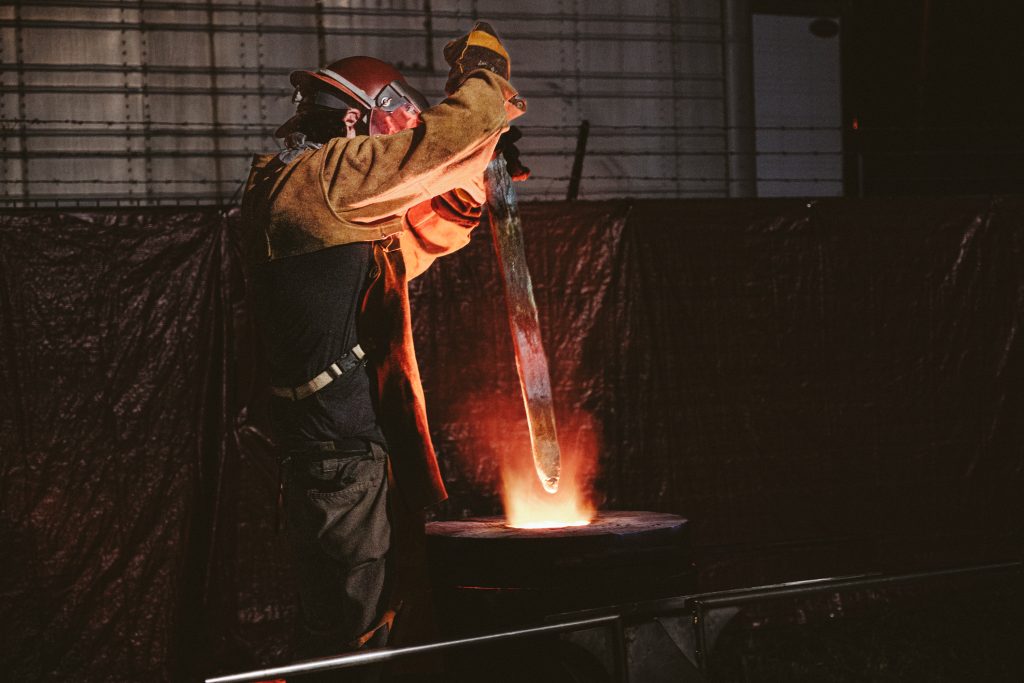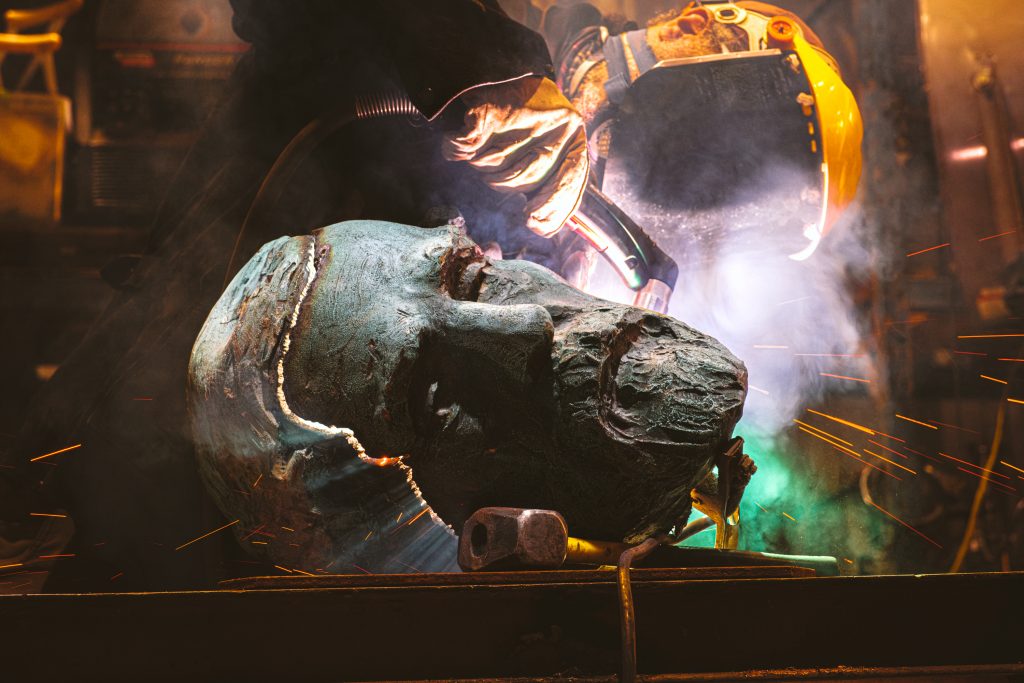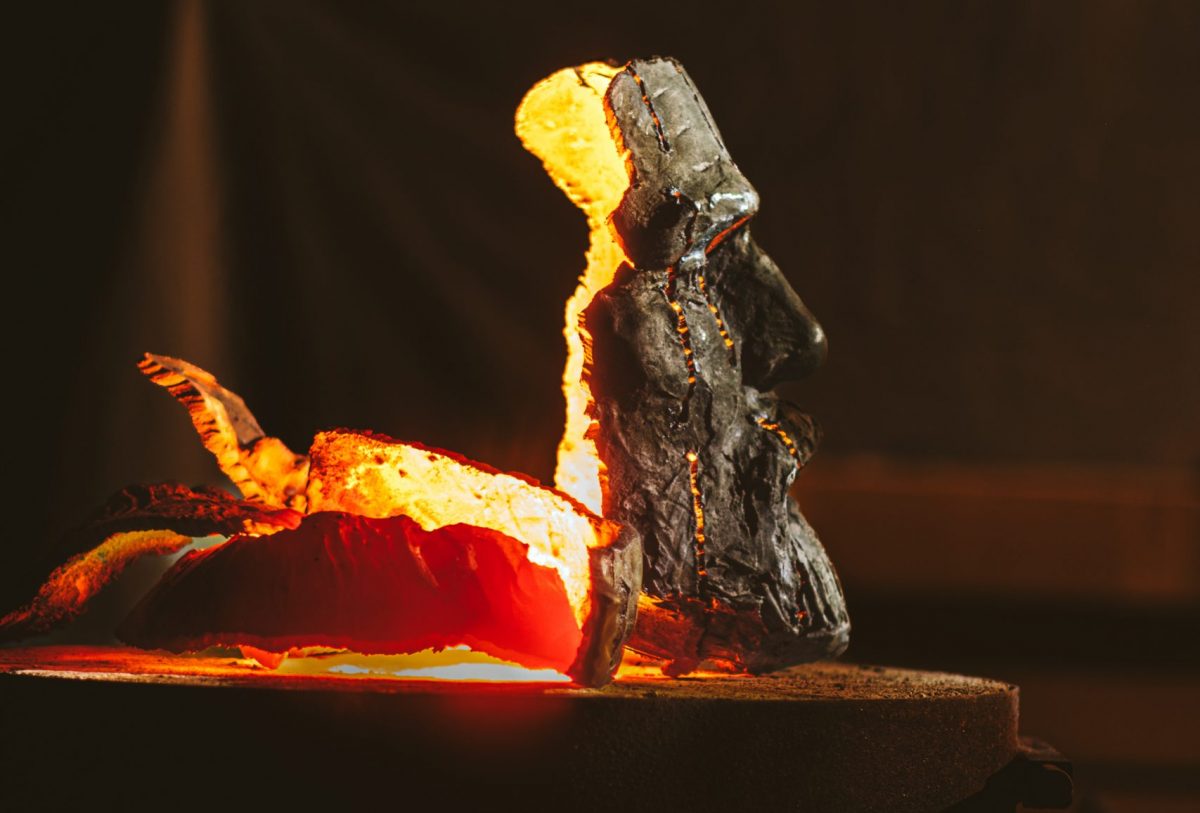The statue of Confederate general Robert E. Lee that has roiled Charlottesville since 2016—and led to 2017’s deadly influx of white supremacists—has ceased to exist, at least as a Lost Cause icon. When parts of the bronze monument hit the crucible in a 2,200-degree furnace recently, it was a solemn and emotional experience for the two women who orchestrated the melting.
For Andrea Douglas, executive director of the Jefferson School African American Heritage Center, there was a sense of relief that what she set out to accomplish two years ago was finally happening. And there was a visceral feeling. When the light of the torch hit Lee’s face, “in some ways it was beautiful,” she says. “There was a quality to it that was moving.”
For Jalane Schmidt, religious studies professor at UVA and director of the Memory Project, there was “satisfaction that we’re finally moving forward.”
Most meaningful for her was when Lee’s sword went into the crucible. “This was a war fought to keep Black people enslaved,” she says. “To see it going down, down, down…”
Douglas and Schmidt are the originators of Swords into Plowshares, a project to melt down the statue of Lee, which stood in what is now Market Street Park for nearly a century, and to create a new work of public art. “After what the city has gone through, what we have gone through,” says Douglas, “some would see it as a finality but it’s just another step toward a better future.”
The idea harkens to the Isaiah verse in the Bible: “They shall beat their swords into plowshares, and their spears into pruning hooks.”
Schmidt credits two Methodist ministers, Isaac Collins of Wesley Memorial United Methodist Church and Phil Woodson of First United Methodist Church, who held 7am Sunday Bible study classes in 2019 at Confederate monuments. The classes were called “Swords into Plowshares: What the Bible says about Injustice, Idolatry, and Repentance.”
“They talked about white supremacy and the statues being worshiped as golden calves,” says Schmidt. “The theological framing—that resonated with me as a religious studies major and scholar, and also as a Christian.”

Also resonating with Schmidt and Douglas was when the Albemarle Board of Supervisors voted to remove the mass-produced Johnny Reb statue from in front of its circuit court in 2020, and turned it over to the Shenandoah Valley Battlefields Foundation, which works “to preserve the hallowed ground of the Valley’s Civil War battlefields,” according to its website.
“It felt morally wrong,” says Douglas. “New people will have to deal with Charlottesville’s toxic waste in another community. It sort of made us decide on a process we could engage around the Lee statue.”
That included a conversation about “our contemporary moment and that reflects the consequences of white supremacy. Can we create something that is democratic and hopeful?”
Since the 2020 murder of George Floyd, the Southern Poverty Law Center estimates that 168 Confederate symbols have been removed or renamed. Many of those Lost Cause statues are sitting in storage.
Schmidt wrote an op-ed in the Richmond Times-Dispatch in October 2020: “Seller beware: The moral risks of hazardous statue disposal.” People suggested the statues go to museums. “They don’t want them,” says Schmidt, who talked to the Smithsonian and Civil War museums. They don’t have the storage, or would have to reinforce floors to support the multi-ton memorials, she adds.
And both scoff at the idea of contextualizing the 21-foot tall statue in then-Lee Park that Paul Goodloe McIntire gave to Charlottesville in 1924, and that was dedicated with the Ku Klux Klan out in force. “Should we be lauding McIntire for creating segregated spaces?” asks Douglas.
“What, with a mealy-mouthed, caveat-filled plaque with small font that doesn’t really interrupt the visual plane?” asks Schmidt.
“In a multiracial democracy, we should not maintain the artistic equivalent of a ‘whites only’ sign in our public parks in the name of teaching history,” she says.
“We are trying to write an alternative narrative,” says Douglas.
In April 2021, the Supreme Court of Virginia ruled that Charlottesville could remove its Confederate statues, and Swords into Plowshares was ready. The Jefferson School African American Heritage Center proposed melting Lee and creating a new work of public art, and City Council passed a resolution giving the center the statue on December 7, 2021. Another lawsuit followed.
Trevilian Station Battlefield Foundation in Louisa and Tazewell-based Ratcliffe Foundation, which also proposed taking Richmond’s ousted Confederate statues, alleged that the city violated state procurement laws, the Freedom of Information Act, and state laws prohibiting the removal of war memorials.
“This lawsuit was frivolous,” says attorney Christopher Tate, whose firm Flora Pettit represented the Jefferson School pro bono. “It relied on unsupported legal theories and outright fabrications of fact.”
The Ratcliffe Foundation dropped out of the suit when evidence showed it had not been a legal entity since 2015, and the Trevilian Station Foundation voluntarily dismissed it after a judge tossed two of its three complaints. A judge signed Trevilian’s motion on September 26.
Schmidt contends the plaintiffs had a chance to take part in the city’s open process for bids, and that Trevilian Station never submitted a bid. “If they didn’t like the idea, they should have stepped up,” she says. “There was a time and place for that.”

The case shook Douglas’ belief in the legal system. She’s received personal threats, and the heritage center’s website was attacked twice.
Lee’s path to the furnace has been litigious. The first lawsuit filed against the city in 2017 kept the statues of Lee and Stonewall Jackson in place until 2021, albeit shrouded in black plastic for a few months after a neo-Nazi at the violent Unite the Right rally drove his car into a crowd of counterprotesters, killing Heather Heyer and injuring dozens more.
Schmidt was sued by one of those plaintiffs for defamation in 2019, as was this reporter. That case was dismissed. But the lawsuits, the hate mail, the racial epithets, the questioning of the UVA professor’s intelligence—“It takes something out of you, and it’s meant to,” she says.
It also strengthened the women’s resolve to see the melting of Lee through—and to create a template for how other communities might deal with their Confederate castoffs.
Gerald Harlow, president of the Trevilian foundation, did not respond to a call from C-VILLE Weekly, nor did Jock Yellott, director of the Monument Fund, a plaintiff in the 2017 suit against the city and a legal adviser in the most recent suit.
The removal of Confederate statues is a controversial business from which many contractors shied away. So too with the melting of monuments. The foundry owner who took the Lee job spoke to C-VILLE only on the condition that his name and location were not reported, and that he was referred to as Charles—not his real name.
His small foundry has never taken a job of this magnitude, melting the 6,000-pound bronze monument down into 24- and 79-pound ingots. He had time to think about it, and knew other foundries had rejected the job. “I knew it was something that needed to be done,” he says. It came down to, “How much do I believe in disassembling hate and symbols of hate?”
He had private conversations with his employees, and they were aware that other companies had been shunned or forced to file bankruptcy. “We agreed this was an important task that needed to be done,” he says.
At an October 26 press conference, Douglas said, “I am proud to announce today that we have fulfilled our promise to the city and to our supporters to melt Charlottesville’s statue of Robert E. Lee—the same statue that was at the center of the deadly Unite the Right rally in 2017.” There were whoops and applause from Swords into Plowshares supporters in front of the Charlottesville Circuit Court.
The next step is to form a jury and solicit artist proposals, with the goal of announcing a finalist in 2024, the 100-year anniversary of the dedication of the statue, says Douglas. And to raise $4 million for the project. She hopes to have the work installed and donated back to the city by 2027, the 10th anniversary of Unite the Right.
“Our efforts have not been to remove history but bear witness to truths about our racist past and our aspirations for a more equitable future,” says Douglas.
Then-city councilor Kristin Szakos was the first to publicly suggest in 2012 the Confederate monuments should be removed, and she was “castigated,” says Schmidt. In 2016, 15-year-old Charlottesville High student Zyahna Bryant collected 700 signatures on a petition to remove the statues, and faced threats, says Schmidt.
She notes the success of “Jim Crow propaganda” artworks that “tricked generations of Americans into adopting a Lost Cause misinterpretation of the Civil War,” and that, like Lee and Jackson, stood in public parks for nearly a century.
“Swords into Plowshares is born of the conviction that we can transform white supremacist trauma into something beautiful,” she says. “Creativity and art can express democratic, inclusive values. We believe that art has the potential to heal.”
A photographer’s history of Lee

Normally reporters don’t want to become part of the story. But photographer Eze Amos has been shooting the statue of Robert E. Lee since 2016, when then-vice-mayor Wes Bellamy announced Zyahna Bryant’s petition to remove the city’s Confederate statues.
“It was the first time C-VILLE ran my photos,” recalls Amos.
He was there at tumultuous City Council meetings. He was there when the Ku Klux Klan came to town in 2017. He was clocked by a neo-Nazi wearing a Hitler T-shirt at the Unite the Right rally. He photographed Lee and Jackson wrapped in black plastic tarps—and again when they were unwrapped. He traveled to Montgomery, Alabama, when 100 citizens made a civil rights pilgrimage in 2018.
And he was there to photograph Lee one last time, as the dismantled general met a fiery furnace.
“It was a mix of emotions in a lot of ways,” says Amos, “the way a chapter closes is also the beginning of something new.”
He says, “It was an honor and privilege to witness, to be documenting this object of hate and fear, to be able to tell the final story of that statue. Where have you heard of a statue being melted?”
Amos moved here from Nigeria 16 years ago. “I always wanted to play a major role in my community,” he muses. “I had no idea it would be of this magnitude.”
